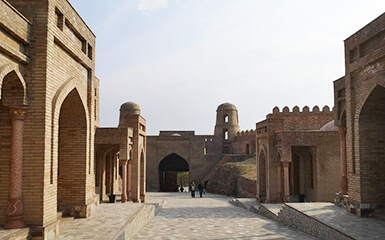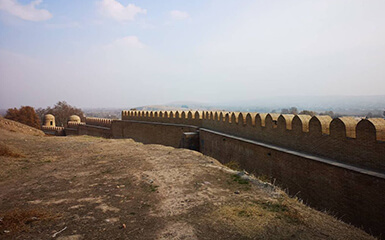Kok Gumbaz
Ajina Teppa
Ancient Panjakent
Anzob Tunnel
Beshkent Qala
Childukhtaron
Khazrati Shokh
Mug Teppa
Gharm Chashma
Hisor Historical
Haji Yaqub mosque
Hazrati-Bobo complex
Lake Iskanderkul
Kalai-Khumb
Karatag
Karon
Khishtin caravanserai
Khorog
Khulbuk
Lake Karakul
Abdullatif Sultan
Madrasai Kuhna
Abu Abdullah Rudaki
Khoja Mashhad
Khudoyor Valami
Makhmudi Azam
Mir Sayyid Ali Hamadani
Muhammed Bashoro
Sheikh Muslihiddin
Nurek Mountain Lake
Pamir
Sarazm
Sari-Khosor
Seven Lakes
Shirkent
Chiluchorchashma
Takht-i Sangin
Hisor Fortress

The settlement is located in the densely populated and fertile Hisor Valley, named after it, at around 800 to 825 m above sea level. The climate is strongly continental. The Chanaka River, a tributary of the Kofarnihon, traverses the city. The entire urban area covers about 9.6 km².
In prehistoric times up to around 2000 BC, the area around Hisor was inhabited by carriers of the Hissar culture, a late Neolithic cultural group that was particularly widespread in the river valleys of the Kofarnihon and Vakhsh in southwest Tajikistan.
In the 18th and 19th centuries, the village belonged to the sphere of influence of the Emirate of Bukhara (Eastern Bukhara), whose rulers had a large fortress built here. The Red Army then captured this in 1921.
In 1929, Hisor was connected to the Dushanbe – Termiz railway line. The corresponding station was named "Chanaka".
It was not until June 26, 1991, after the country of Tajikistan gained independence, that Hisor received city status and became the centre of the Rajon of the same name. In 2005, the place was restructured as a city-like settlement.
The most important building in the city is the old fortress. It was laid out in the 18th century as the summer residence of the emirs of Bukhara and greatly expanded in the 19th century. Today it consists of two high hills. The fortress wall, which is up to a meter thick and contains loopholes, and the large entrance gate are well preserved. This includes two conical towers that frame the entrance arch.
The Registan is located in front of the entrance gate of the fortress. Two madrasas, an older two-story from the 18th century and a younger one from the 19th century, which has been largely destroyed today, occupy the other side of this square. The old madrasah has a large inner courtyard with entrances to the cell-like rooms. Up until the beginning of the 20th century, around 100 to 150 Koran students were taught here. Today, the older of the two madrasahs houses a small museum displaying local clothing, ceramics and jewellery, and a library. Behind the madrasah is the mausoleum of Makhtumi Azam (Pers. For "Great Master"), an Islamic teacher of the 16th century. This is probably the Khoja Mohammed Chaivoki.

